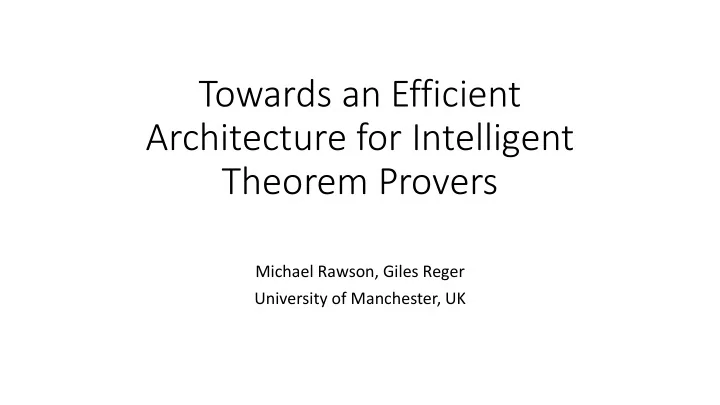

Towards an Efficient Architecture for Intelligent Theorem Provers Michael Rawson, Giles Reger University of Manchester, UK
“The problem with all this deep neural stuff is that it’s slow. ” AITP ‘19 participant, paraphrased Background
Efficient ATP Context • Fully automatic provers: “fire and forget” • Supporting full first-order logic (with equality) • Historically, little learning from experience • Instead use efficient calculi and highly-tuned algorithms
Automatic theorem proving: an abstract view 1. Are we done yet? 2. No? Ugh, fine. 3. Pick a Thingy. 4. Do All the Things™ with your Thingy. 5. Go to (1)
What do we want? • Learn from past experience proving things • Guide future prover runs based on the knowledge gained • Ideally without affecting “raw” performance too much
Guidance is Hard • Optimal picking is not decidable in general • Can work for human problems: human mathematicians exist • Thingies (formulae, clauses…) generally hostile for learning: • “Lossy” representations: definitionally not as good as they could be • “Lossless” representations: better (?), just really difficult .
Guidance is Inefficient (?) • Direct guidance means adding a heuristic “black box” • Use it to pick your Thingies better • Therefore, at least one heuristic call per loop • If your heuristic does a lot of computation (neurally?), this is slow • Claim: neural networks are not low-throughput, merely high-latency
A Solution Well, maybe.
Desiderata for neural provers • Proof state must be reasonably small • Proof state must be human-readable • Proof state must be independent and self-contained • Proof state must be capable of evaluation in (data)-parallel
A suitable calculus • Refutation tableaux (proof state is small, parallel) • Non-clausal tableaux (proof state is small, human-readable) • Tableaux without unification (proof state is independent, parallel) • This is horrible for proof search…
https://en.wikipedia.org/wiki/Method_of_analytic_tableaux#/media/File:First-order_tableau.svg
Problem: explosive proof search • Necessarily explosive calculus • Solution: can be controlled if the heuristic is good enough
Problem: controlling exploitation • Heuristic guides proof search, but it gets it wrong occasionally • Proof search might become “stuck” and therefore incomplete • Must balance exploitation versus exploration • Solution: Monte-Carlo Tree Search, as used in MonteCoP/rlCoP
https://en.wikipedia.org/wiki/Monte_Carlo_tree_search#/media/File:MCTS_(English)_-_Updated_2017-11-19.svg
Problem: deep proofs • Proofs can be significantly deep with this method • Solution: apply an existing fast oracle ATP (Z3 with MBQI) to subgoals • Sound because each sub-goal is independent of any other • Could also be any first-order ATP or counter-example finder • Oracle says: • “satisfiable”: you messed up, prune this branch • “unsatisfiable”: great, this subgoal is solved • “unknown”: keep going…
A Prover Design • Tableaux search via MCTS • Fresh nodes placed on a queue, heuristic evaluates in batches • Heuristic estimates “truthiness” of current subgoal • Update nodes with scores when they arrive from the heuristic • Explore other areas in the meantime • Whack subgoals with a Z3 hammer occasionally, in parallel
Oracle (saturates CPU) Proof Search (saturates GPU) Heuristic
Some advantages • Common subgoals can be shared • Quite general: new inference rules, other logics? • All available CPU/GPU cores utilised • Possible fast incomplete mode: drop poor branches • Oracle generates training examples during proof search • Pluggable oracle – is this a new domain for traditional ATPs ? • Pluggable heuristic – I might make this a competition !
Findings
Engineering • Relatively simple to implement: one (definitely non-expert) author • However, parallel DAG traversal/update very difficult to get right! • ≈ 2,000 lines of Rust code • Batching neural heuristic much more efficient • Z3 quite expensive, but definitely worthwhile
Mizar benchmark • MPTP dataset, minimised (“m40” - thanks to Josef Urban) • A mathematical benchmark: unclear how other domains fare • Results promising, but Z3 is a strong prover already. • Apologies for no numbers…
Learning from experience • Simple database lookup of previously-proved sat/unsat subgoals proves ≈5% more, with significant speedup • Neural heuristic learns to 55% accuracy – surely this can be improved! • Can bootstrap from a problem set, even if no problems are solved initially
Conclusions
Results • Neural ATPs are not necessarily slow, just different • Need new calculi/provers • Parallel theorem provers are a necessary evil for the future • Significant advantages (and disadvantages!) to doing it the stupid way
Future work • Make sure the thing is sound! • Evaluation on MPTP • More training data, better heuristics • “FOL truthiness” ML competition? • Engineering for efficiency
Questions
Recommend
More recommend